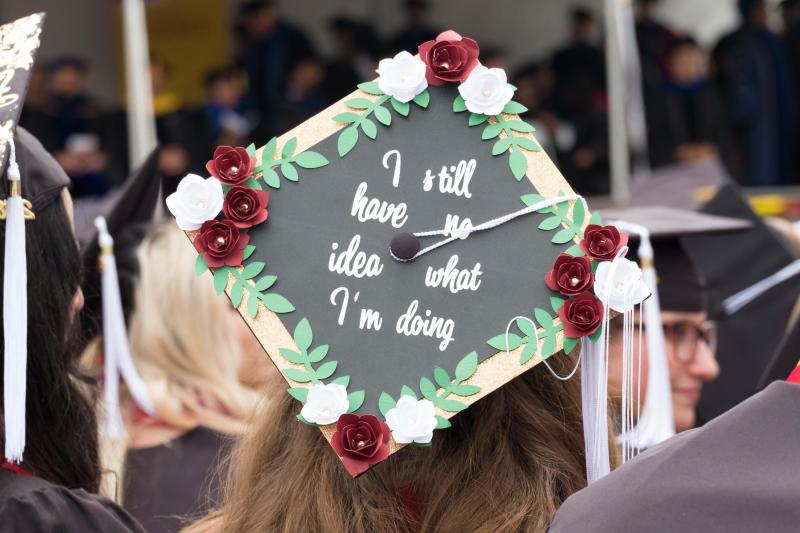
“Rarely do students get to do this while they are undergraduates,” said Stanislaus State President Ellen Junn. “We want to help students contemplate their future professional lives with intention and with support. College should expand horizons. We want students to not just plow through a checklist of courses. They need to explore and entertain ideas and dream.”
“Designing Your Tomorrow,” a seven-session continuing education program that wrapped up May 2, took a holistic approach to vocational futures based on Stanford University’s Design Your Life program.
“Get curious. Talk to people. Try stuff — that’s really it,” said Dave Evans of Stanford, who co-created what he calls classes in, essentially, “what you want to do when you grow up.” Identify an interest. Ask questions. Repeat until engaged.
At Stan State, “Designing Your Tomorrow” workshops are being developed using a $50,000 CSU Innovation Development Grant. Julie Sedlemeyer, director of the Career and Professional Development Center, and Helene Caudill, dean of University Extended Education, collaborated to submit the grant. The goal is to develop four targeted programs: (1) juniors, seniors and graduate students exploring career opportunities, (2) freshmen and sophomores finalizing a choice of major, (3) alumni and community members wanting to explore alternative career and life choices and (4) high school students exploring their higher education options.
In addition to a certificate of completion, the continuing education units awarded will emphasize the importance of life-long learning. This fall, the focus is on a workshop for freshmen and sophomores, and one for juniors and seniors. Both will be team-taught certificate “pop up courses” offering Continuing Education Units (CEUs).
Faculty interested in helping develop and lead the courses are encouraged to participate. Junn said she and Provost Kimberly Greer were so excited by the project they are planning to team-teach one of the courses this Fall.
“Many students do not have clear and definitive ideas of what they will do after graduation. First-generation students, who make up 75 percent of our campus, likely will have less familiarity with University disciplines or what career options might exist for those majors,” Junn said.
“We have other career courses, but this is a very different way of approaching vocations. It opens up thought processes,” said Stan State series co-founder Harold Stanislaw. “I think this approach is much more helpful. We are preparing students for jobs in a paradigm that doesn’t exist yet.”
Stanislaw and fellow psychology professor Bruce Hesse were in the Stan State delegation joining Harvard, MIT and 11 other schools last summer at a Stanford seminar on implementing its course. They arranged and led the spring workshops with Ellen Bell, associate professor of archaeology, and Director of Career Development Julie Sedlemeyer.
“I went to Stanford somewhat skeptical. But the design thinking approach has opened up new ways for me to do creative things in my regular classes,” Hesse said, speaking to around 20 students who attended the workshops.
Senior Branden Escobar said he signed up for the workshops not knowing what they would offer. “I expected to get a bunch of advice on how to get along after college, like how to write a resume,” Escobar said. “But I’m taking a class in design principles for production, and this really was about applying design principles to my life. I thought that was really cool.”
Students attending the final workshop meeting said they had increased their confidence, lowered their stress and allowed them to voice shared fears of still-blurry futures. The workshop kicked off with upbeat music and pizza. Between class activities, two speakers traced their zigzag career paths and offered insights learned along the way.
Kieran Campbell, one of Google’s top-selling account executives, video-conferenced with the group. In college, he said, an injury ended plans to be a pro athlete. After graduating, he sent out dozens of unanswered resumes before being hired by a social media start-up. Google bought the start-up and, with tenacity and follow-through, he found his niche.
“The best-laid plans can go awry and you have to be flexible,” Campbell said, adding after college, “the only constant is change.” Networking takes persistence and follow-through, he said. “My philosophy has always been, if that door cracked open I was going to shove my whole foot through it.”
His last bit of advice: “When you point out a problem, take the initiative and have a potential solution.” Even an imperfect solution shows a proactive mindset.
The second speaker was Mila Amerine Dickens, founder of the Central Valley Autism Project. As a college student, she vacillated between majors and spent aimless months after graduation. She found her calling as a Stan State graduate student in psychology. A volunteer project to help a young autistic child led her to the cutting edge of a new industry.
Over the next 30 years, her single project grew into a major organization, calling for business skills she never imagined she would need, Dickens said. “Do your homework. Know what’s waiting for you out there when you’re done,” she advised students. “I didn’t have a plan, but I didn’t hesitate when an opportunity presented itself.”
For faculty interested in teaching a future Design Your Tomorow class, there will be a half-day retreat later in June or early July.